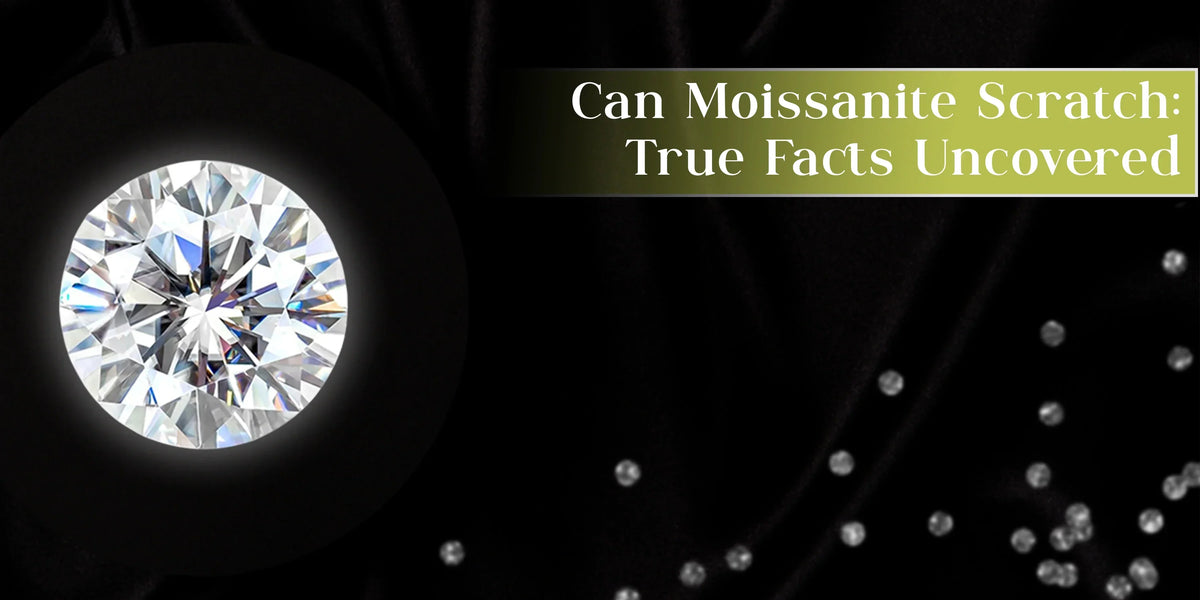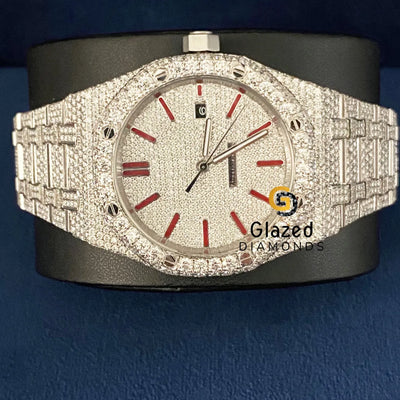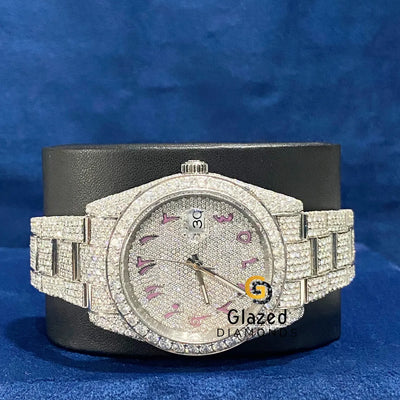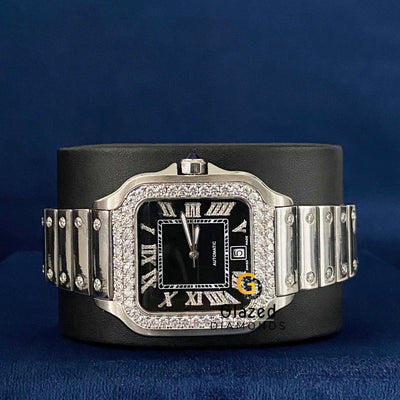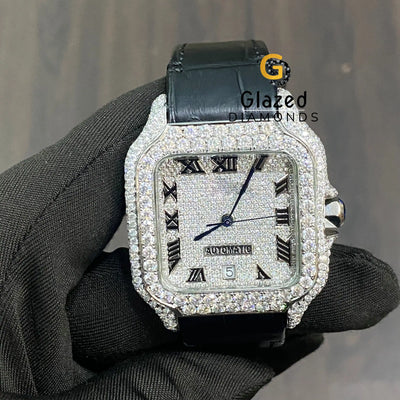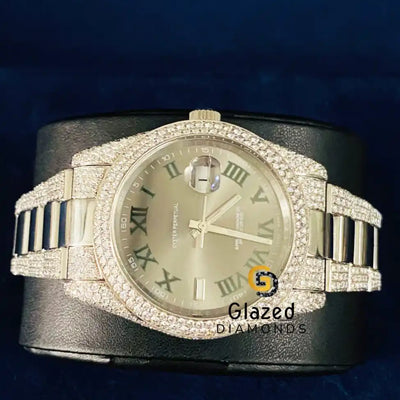Moissanite is extremely hard. In day-to-day life it almost never scratches. On the Mohs scale it sits around 9.25, which means keys, coins, steel, glass, ceramics, and quartz dust do not scratch it.
Only harder or equal-hardness abrasives can mark it, like diamond, another moissanite under pressure, or industrial grits such as silicon carbide sandpaper or diamond paste. Most “scratches” people see are not on the stone at all. They are films of soap and oils, or scuffs on the metal setting or watch crystals around the stone.
That is the practical reality. If you stop here, you already know enough to wear your ring, pendant, or watch without tip-toeing. If you want the full picture and a few care tricks that keep it blazing, read on.
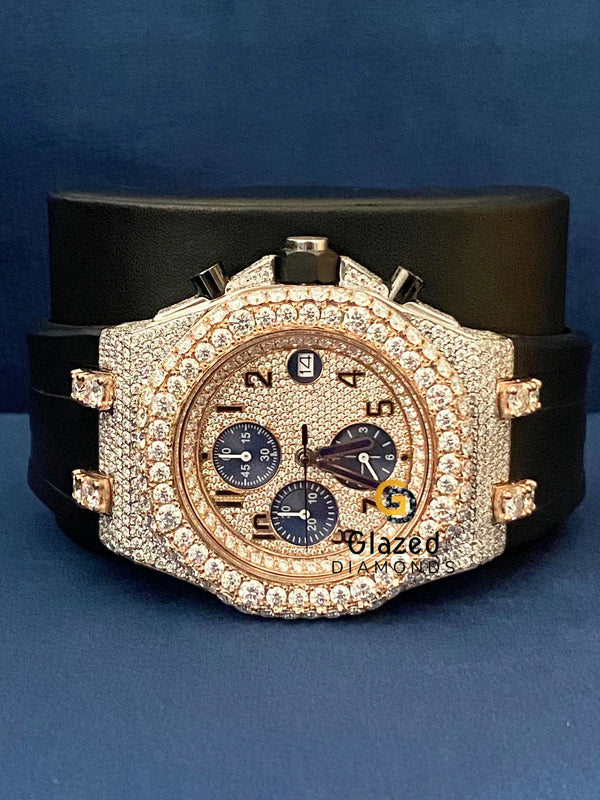
Chronograph Arabic Dial Silicone Black Strap Hip Hop Moissanite Watch
$1,000.00 Save $200.00
Hardness vs Toughness
Hardness is scratch resistance. Moissanite is very hard, second only to diamond in normal jewelry life.
Toughness is resistance to chips from sharp blows. Like a diamond, moissanite is hard, but a direct hit on an exposed edge can still chip it. That is true for almost any faceted gem.
So yes, moissanite is hard to scratch, but do not hammer it into granite countertops. If it takes a sharp blow on a vulnerable facet edge, you could chip a corner without ever scratching the surface.
>What Can Actually Scratch Moissanite

Here is the honest list. Most of it you will never encounter by accident.
-
Diamond. Any diamond tool or diamond jewelry that rubs hard against the moissanite’s surface can scratch it.
-
Another moissanite. Materials of equal hardness can scratch each other under pressure. Tossing moissanite pieces together in one pouch is not a good idea.
-
Industrial abrasives. Silicon carbide sandpaper, diamond paste, and lapidary compounds can mark it.
-
Exotic super-hard materials. Not part of daily life, but yes, some advanced abrasives used in manufacturing exceed moissanite.
Notice what is missing: pocket change, phones, cutlery, granite counters, ceramic mugs, gym equipment, door handles. None of those are harder than moissanite.
>What Will Not Scratch It in Normal Life
-
Quartz sand and dust around 7 Mohs. This is why beaches and sidewalks are not a threat to the stone’s surface.
-
Steel around 4–4.5, even so-called hardened grades used in appliances and tools.
-
Glass around 5.5. Moissanite will scratch glass, not the other way around.
-
Ceramics used in common household items.
-
Gold or silver in settings and chains. These are soft compared to moissanite.
A Quick Hardness Table You Can Use
|
Material |
Mohs hardness |
Can it scratch moissanite |
|
Talc |
1 |
No |
|
Copper coin |
~3 |
No |
|
Knife steel |
~4–4.5 |
No |
|
Window glass |
~5.5 |
No |
|
Quartz (sand) |
7 |
No |
|
Topaz |
8 |
No |
|
Corundum (sapphire, ruby) |
9 |
Unlikely in normal contact |
|
Moissanite |
~9.25 |
Equal materials may scratch each other |
|
Diamond |
10 |
Yes, can scratch moissanite |
Two takeaways. In the real world you rarely meet sapphire rubbing point-to-point against your stone, and almost never rub it with a diamond on purpose. Day-to-day, your moissanite is safe.
Why Your Stone Looks “Scratched” but Probably Is Not

Three common culprits.
-
Film on the stone. Skin oils, lotion, soap residue, sunscreen, and hairspray leave a film. Film scatters light and mimics fine scratches.
-
Scratches on nearby metal. Prongs and bezels are softer than moissanite. They pick up scuffs first.
-
Scratched crystal on a watch. Mineral glass and some coatings pick up micro-marks. The moissanite is still pristine.
Fix: Soak the piece in warm water with a few drops of mild dish soap, gently brush with a soft toothbrush, rinse, and pat dry with a microfiber cloth. Most “scratches” vanish with that routine.
>Care Tips That Keep the Face Crisp
-
Wipe after wear. A 5-second microfiber wipe removes oils before they harden.
-
Weekly clean. Warm water, tiny bit of dish soap, soft brush, rinse, dry.
Avoid harsh chemicals. Bleach, chlorine, and abrasive powders are not your friends. -
Store pieces separately. One pendant per pouch. Do not let moissanite rub against diamond or another moissanite.
-
Service the setting. A jeweler can check prongs, tighten a loose stone, and polish the metal every year or two.
Rings, Pendants, and Watches Have Different Risk Points
-
Rings: They hit counters and door frames most. The stone surface still resists scratches, but facet edges near prongs can chip if struck hard. Low, protective settings help if you are hands-on all day.
-
Pendants: Safer than rings. The main risk is storing them against other stones in the same pouch.
-
Watches: The moissanite around the bezel stays clean longer than the crystal. Most dullness you see is on the crystal or the metal, not the stones. Sweat and lotion collect at bracelet links. A soft brush fixes that in minutes.
Real Scenarios and What to Do
-
You bumped a countertop and now see a line. Clean it first. If the line remains only at one angle and disappears when you rotate the piece, it is usually a mark on the metal or residue sitting on the stone.
-
Your ring looks dull after the gym. Sweat and soap film, not scratching. Do the quick soak and brush.
-
You dropped the ring on the tile and saw a tiny nick on a corner. That is a chip, not a scratch. A jeweler can often polish or re-facet a small area, or slightly adjust a prong to protect it.
Myths to Stop Worrying About
-
“Moissanite scratches easily over time.” No. The crystal is hard. It does not develop internal clouding or a network of scratches from normal wear.
-
“Sand at the beach will scratch it.” No. Quartz sand is softer. Rinse the salt, clean the film, enjoy the view.
-
“Only diamonds are safe for daily wear.” Diamonds are harder, but both diamond and moissanite can chip on impact. Sensible wear and a protective setting matter more than a single number on a chart.
Simple Routine That Keeps It Sparkling

-
Take it off for heavy yard work or weight racks.
-
Wipe after wear with a soft cloth.
-
Quick soap soak and brush once a week.
-
Separate storage. Never toss jewelry together in one dish.
-
Yearly check of prongs and clasp. Two minutes at a bench saves headaches.
When You Might Want Extra Protection
-
Very large stones with high crowns. Taller crowns look amazing but expose more edge. Consider a bezel or semi-bezel if you are hard on your hands.
-
Iced-out bezels on watches. They are safe, but they will collect more film. Plan on a soft-brush rinse once a week if you wear the watch daily.
The Final Advice
Can moissanite scratch? In practical terms, no. Not from keys, phones, countertops, sand, or the thousand small contacts of daily life. Only diamond, another moissanite under the wrong conditions, or industrial abrasives can mark the surface. What you read as “scratches” nine times out of ten is just residue or scuffs on nearby metal.
Treat your piece like a real piece of fine jewelry. Wipe it down, clean it once a week, store it by itself, and let a jeweler check the prongs once in a while. Do that and the stone will keep the same crisp facets and sharp fire you saw on day one. The shine is all natural. Your routine just keeps it visible.

